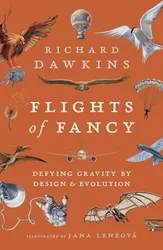Flight is one of the techniques that has evolved several times in the animal kingdom, and is also something that humans have learned to do with machines. This book explores the different ways that plants and animals use flight through the air to survive, feed and reproduce. It also covers the human inventions that have allowed us to take to the air, and compares the different methods humans have engineered with those that have evolved in the natural world.
As well as creatures that use a form of powered flight, such as birds, bats and insects, the book also covers lots of methods of unpowered flight, including balloons, human gliders catching thermals to gain height, tiny organisms (“aeroplankton”) that float in the air, and plants that distribute their pollen or seeds in the air.
I found the sections on insects particularly interesting, especially those with oscillatory muscles to control the beating of their wings. So rather than having separate muscles for up and down strokes, and controlling these movements individually as a bird would, the wings just ‘turn on’ and vibrate at very high frequencies to enable flight.
Although the book discusses how things like wings could have first evolved, it goes into less detail about evolution than some of Dawkins’ other books, such as The Selfish Gene. Instead, it looks more at the end results of evolution, to explore how flying works now and how it benefits the organisms that have evolved it. However, there are some very interesting sections on how wings developed in various animals, and which existing structures were co-opted by evolution to enable their development. There’s also discussion on how birds (or their dinosaur ancestors) first gained flight, and whether this was by initially gliding down from trees, or by taking longer and longer running jumps from the ground.
The illustrations in this book, by Jana Lenzová, are stunning. I often complain that books don’t contain enough illustrations to complement the text, but I have no such complaints here! There is an illustration for almost every creature and device mentioned in the text, and they strike the right balance between being detailed enough to clarify what the text is saying, while remaining artistic and beautiful to look at. As well as the full colour images, there are smaller line drawings on just about every page.
Weirdly, there are some strange typesetting errors in this book, where several words seem to be unnecessarily hyphenated. In a book that is so beautifully produced and with such attention to detail evident elsewhere, this really sticks out. I was trying to figure out if they were intentional or an unusual affectation by the author, but the way they seem to happen at random places in words suggests they are a mistake. It doesn’t spoil my enjoyment of this book, but it’s a bit strange.

As it covers so many different flight-related topics, I found that it didn’t go into all that much detail on any of them. I did find this a little frustrating, but as a general overview of flight in the natural world, it’s a really fun book to read, and the amazing illustrations really add to the experience.
